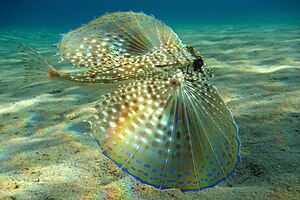Flight cock
| Flight cock | ||||||||||||
|---|---|---|---|---|---|---|---|---|---|---|---|---|

Flying cock ( Dactylopterus volitans ) |
||||||||||||
| Systematics | ||||||||||||
|
||||||||||||
| Scientific name of the genus | ||||||||||||
| Dactylopterus | ||||||||||||
| Lacepède , 1801 | ||||||||||||
| Scientific name of the species | ||||||||||||
| Dactylopterus volitans | ||||||||||||
| ( Linnaeus , 1758) |
The flight Hahn ( Dactylopterus volitans ) is a type of bony fish from the family of air valves . It is characterized by very enlarged pectoral fins, which it uses like wings when swimming. The species can be found in both the eastern and western Atlantic.
features
The flying cock has an elongated, conical body with a large head that is almost square in cross section. It reaches an average body length of 15 centimeters, the maximum length can be up to 50 centimeters. The steeply sloping head has a large, very wide and terminal mouth with fleshy lips. It is armored with helmet-like skin plates that terminate in two large spines and with numerous strips. The back and flanks are gray or brown with light and dark spots, the belly is white or pink. The wing-like extended pectoral fins have a bright blue border and numerous blue spots and lines arranged in patterns.
The pectoral fins are wing-like and very much enlarged, so that they extend far behind the attachment of the anal fin. The foremost six fin rays are separated from the main fin and form their own lobe . The pelvic fins are throaty. The dorsal fin is divided, the front dorsal fin consists of 8 hard rays, the second one hard and 8 soft rays and the anal fin has 6 soft rays. 60 to 62 scales run along the center line of the flanks.
distribution
Its distribution area extends in the East Atlantic from Great Britain to Angola including the Mediterranean , the Azores and Madeira . In the western Atlantic it is found from Canada to Massachusetts , in the Gulf of Mexico and to the coast of Argentina .
Way of life
The fish lives mainly on sandy and muddy bottoms at a depth of 10 to 30 meters, less often in deeper areas up to 80 meters. It feeds mainly on invertebrates such as crabs , mollusks and worms.
The spawning season falls in summer. The eggs are released into the open water and float in the surface water due to stored oil droplets.
supporting documents
- ↑ a b c d Flugahn on Fishbase.org (English)
- ↑ a b c d e Andreas Vilcinskas : Fish - Central European freshwater species and marine fish of the North and Baltic Seas . BLV Verlagsgesellschaft, Munich 2000; P. 170. ISBN 3-405-15848-6 .
literature
- Andreas Vilcinskas : Fish - Central European freshwater species and marine fish of the North and Baltic Seas . BLV Verlagsgesellschaft, Munich 2000; P. 170. ISBN 3-405-15848-6 .
Web links
- Flugahn on Fishbase.org (English)